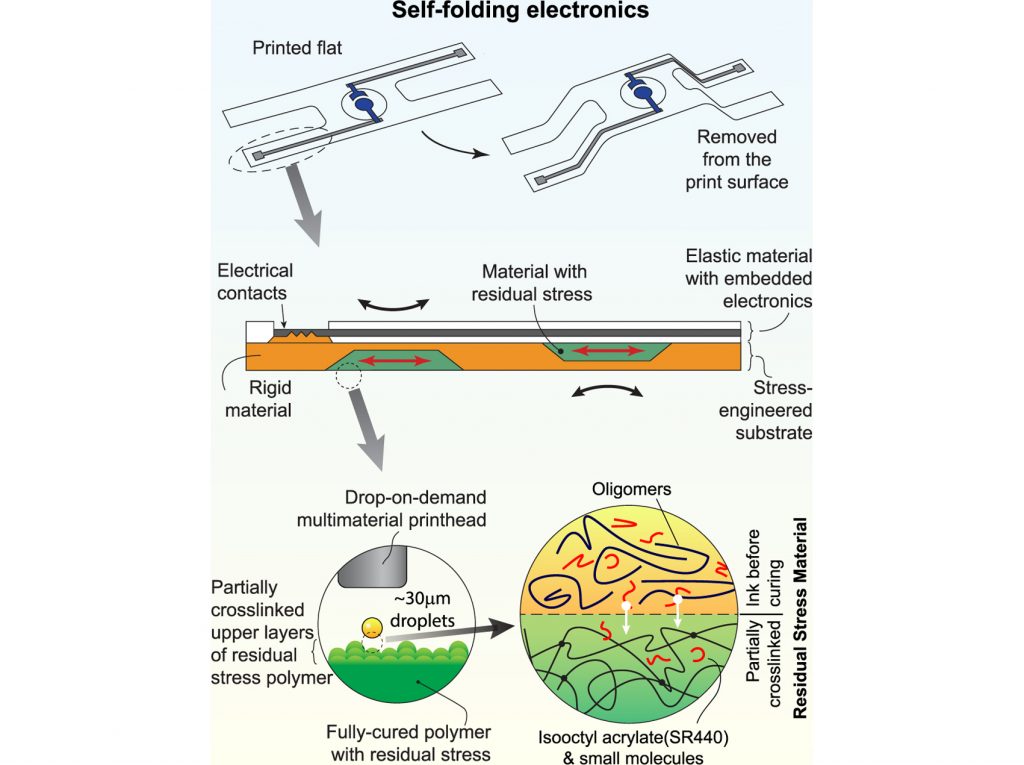3D printing with added time, i.e. “4D printing”, is an industry trend bringing about self-actuating and assembling objects that could one day bring improvements to areas of construction, clothing and wearable tech.
Typically, 4D printed objects require the application of a stimulus, such as heat or water, for activation. However, in a new development from the Computer Science and Artificial Intelligence Laboratory (CSAIL) at Massachusetts Institute of Technology (MIT) and North Carolina State University, researchers have developed a material that folds entirely independent of any external conditions.
The material brings new potential to the field of flexible electronics, considered by some to be “the holy grail” of 3D printing.
Flexi-electronics
This new self-folding demonstration is based on CSAIL’s responsive robotic skin research. Though previously inspired by the color changing abilities of a golden tortoise beetle, the basic principle of both studies is to test and develop an electronic material that is stretchy and flexible.
Note the change in color of the inset left “pixel”. Clip of a responsive electronic skin demo from 3D-Printed Autonomous Sensory Composites by MIT Computational Fabrication Group on YouTube
Don’t add water
As explained by Subramanian Sundaram, an author of the recent CSAIL/NC State study and MIT grad student, the majority of printed electronics rely on some form of organic material, defined as “carbon-based compounds, originally derived from living organisms.”

“These materials are often very, very sensitive to moisture and temperature,” adds Sundaram, “So if you have these electronics and parts, and you want to initiate folds in them, you wouldn’t want to dunk them in water or heat them, because then your electronics are going to degrade.”
Engineered stress
The ink developed in this research is tuned so that it expands as it hardens. Activation is made possible thanks to the layer-by-layer approach of 3D printing.
The first layer of ink is printed with shallow wells in the surface, and cured to become solid. A second layer is then 3D printed “drop on demand” filling the wells with semi-solid residue. The final layer is an elastic material embedded with an electronic strip.
When peeled away from the print bed, the stress-wells created in these layers cause the device to bend on demand.

Further reading
Commenting on the MIT/NC State research Professor Michael Dickey, from the department of chemical engineering at NC State says, “This work is exciting because it provides a way to create functional electronics on 3D objects….[it] provides a route to create electronics using more conventional planar techniques on a 2D surface and then transform them into a 3D shape, while retaining the function of the electronics.”
“The transformation happens by a clever trick to build stress into the materials during printing.”
The supporting paper for the research discussed in this article, titled 3D-Printed Self-Folding Electronics, is available open-access in the ACS journal of Applied Materials and Interfaces. It is co-authored by Subramanian Sundaram, David S. Kim, Marc A. Baldo, Ryan C. Hayward, and Wojciech Matusik who features in an interview with Michael Petch about the future of 3D design.
Materials, hardware and software are all covered 6 times a week in the free 3D Printing Industry newsletter. Sign up here to be the first in the know, and find us on social media for stories as-they-happen.
We will soon be launching our specialist site for jobs in 3D printing. Register here and don’t miss out.
Featured image shows MIT/NC State’s self-folding 3D printed electronics. Photo via MIT.


